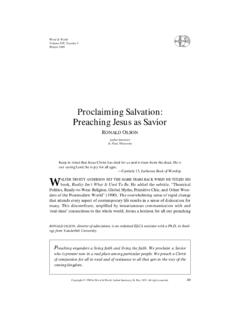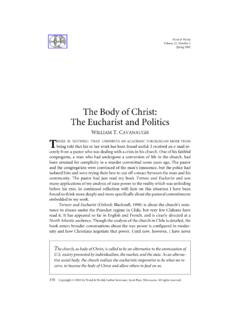Transcription of Salvation in Luke-Acts
1 Word & World 12/1 (1992)Copyright 1992 by Word & World, Luther Seminary, St. Paul, MN. All rights 5 Salvation in luke -ActsMARK ALLAN POWELLT rinity Lutheran Seminary, Columbus, OhioI. DEFINING Salvation IN luke -ACTSThe purpose of this article will be to describe luke s concept of Salvation in a moresystematic fashion than luke himself would ever have The charts accompanying thisarticle [at end of text] provide some of the data that needs interpreting. These charts examine thecontexts in which the key words soter (savior), soteria ( Salvation ), soterion ( Salvation ), andsozein (to save) occur in luke s writings. For each occurrence, we have identified the person orpersons to whom Salvation is offered, the content given to this Salvation (what it means), thebasis for this Salvation (who or what brings it), and the means through which this Salvation is tobe Persons to Whom Salvation Is OfferedLooking down the first column of the charts, we are struck by the great diversity ofpersons who are real or potential recipients of Salvation in luke s writings.
2 luke hasintentionally included men and women, adults and children, Jews and gentiles, and personsrepresentative of various social classes in his accounts of Salvation . He wishes to emphasize thatsalvation is for all ( luke 2:31; 3:6; acts 2:21).2. The Content of SalvationThe second column on the charts reveals a similar diversity with regard to the content ofsalvation, which appears to be determined in each instance by the needs of the person or personsinvolved. Can we construct a definition of Salvation in Luke-Acts that does justice to all of thepossible applications listed on our charts? I1 For surveys of the views of various scholars on this and other Lukan themes, see my What Are TheySaying About luke ? (New York: Paulist, 1989) and What Are They Saying About acts ? (New York: Paulist, 1991).page 6propose the following: Salvation in Luke-Acts means participation in the reign of God.
3 We canfill this out with three further observations:a.) The reign of God in Luke-Acts is both a present ( luke 11:20; 17:21) and a future( acts 22:18, 29-30) reality. Therefore, Salvation has both present and future dimensions. Aglance at column two on our charts, however, reveals that luke emphasizes the presentdimensions over the future ones. luke recognizes that people are interested in receiving eternallife ( luke 10:25; 18:18), and he affirms the legitimacy of this hope ( luke 18:30; acts 13:48);but, in general, he lays more emphasis on the life that God s reign makes possible here and is brought out by his repeated use of the word today in significant passages ( luke 2:11;3:22; 4:21; 5:26; 19:5, 9; 23:43). Defined as participation in the reign of God, Salvation meansliving life, even now, as God intends it to be ) Participation in the reign of God may involve either the introduction of positivefeatures (peace, blessing, eternal life) or the removal of negative ones (disease, demons, sin).
4 Byincorporating both elements into his concept of Salvation , luke does justice to both the Hebrewand Greek backgrounds out of which hepage 7writes. The Jewish world typically associated Salvation with deliverance from enemies, whileGreco-Roman society thought of Salvation more as the bestowal of various luke doesnot choose between these options, but presents Jesus as a Savior who is both Messiah and Lord( luke 2:11; acts 2:36). As Messiah, Jesus is the one who fulfills all of God s promises to Israel( luke 4:16-21; 24:27-41); specifically, he is the prophet like Moses promised in Deut 18:15-16,whose new exodus ( luke 9:31) establishes a new covenantal relationship between God andGod s people ( acts 3:17-26; 7:37).3 As Lord, Jesus is the one through whom God s mercy isextended to all ( acts 2:21; 10:36); he meets and surpasses society s expectations of a Hellenistic benefactor by bestowing such divine gifts as healing, peace, and forgiveness of sins (Acts4:9-10; 10:38).
5 4c.) In presenting Salvation as participation in the reign of God, luke makes no2 Werner Foerster, sozo and soteria in the Greek World, in TDNT 7 Minear, To Heal and To Reveal: The Prophetic Vocation According to luke (New York: Seabury,1976) Danker, luke , 2nd ed. (Philadelphia: Fortress, 1987) 8distinction between what we might describe as physical, spiritual, or social aspects of Salvation (cf. luke 5:23). God is concerned with all aspects of human life and relationships, and, so, Salvation may involve the putting right of any aspect that is not as it should luke 18:24-26, entering the reign of God and being saved are treated as in the reign of God is a present possibility, that involves liberation from anythingthat prevents one from living life as God intends (cf. luke 4:18-19).II. THE BASIS OF Salvation IN luke -ACTSIn Luke-Acts , Salvation is of God ( luke 3:6; acts 28:28).
6 God is Savior ( luke 1:46).As the third column on our charts reveals, Salvation in Luke-Acts is frequently based simply onthe inexplicable and unmotivated initiative of Salvation is sometimes also linked to others, particularly to Jesus, who is also calledSavior ( luke 2:11; acts 5:31; 13:23). luke does not expound any particular theory of theatonement, but he does believe there is something about Jesus that makes Salvation is it?Surprisingly, luke does not link Salvation to Jesus death on the cross (except, perhaps, inActs 20:28). There is no reference in luke to Jesus giving his life as a ransom (cf. Matt 20:28;Mark 10:45) or shedding his blood for the forgiveness of sins (cf. Matt 26:28). Instead, Lukefinds the basis for Salvation to be manifest in Jesus life and in his presents Jesus as one who is born a Savior ( luke 2:11) and who brings Salvation topeople throughout his earthly life.
7 In fact, the whole reason he has come is to seek and save thelost ( luke 19:10). The life of Jesus has saving significance for luke because it is in the life ofJesus that God s reign is inaugurated and made manifest on earth ( luke 4:43; 8:1; 9:11; 10:9-11;11:20; 17:21). Through encounters with Jesus, people are set free from things that prevent themfrom living life as God intends and, so, are enabled to participate in God s Salvation is readily available to people while Jesus is on earth, what happens after he is carried up into heaven ( luke 24:51)? The entire book of acts may have been written to answerthis question, for from start to finish this book demonstrates that Jesus is not really absent. Jesus ascension is presented as an exaltation to the right hand of God ( acts 7:56) where he remainsaccessible and continues to save The current distance between Jesus and his followers iseasily transcended in various First, Jesus is still capable of actually appearing on earth, ashe does to Saul on the Damascus road ( acts 10:3-7; 22:6-10; 26:13-18).
8 Second, Jesus words toSaul, Why are you persecuting me? ( acts 9:5) identifies Jesus as present in the lives of theChristians whom Saul has persecuted (cf. luke 10:16). Third, Jesus continues to guide andenable his followers through the Holy Spirit, who is called the Spirit of Jesus at one point (Acts16:7). Fourth, Jesus continues to remain active and present through his name, which is invokedcontinuously for baptisms (2:38), healings (3:6), exorcisms (16:18), forgiveness5 Helmut Flender, St. luke : Theologian of Redemptive History (Philadelphia: Fortress, 1967).6 George MacRae, Whom Heaven Must Receive Until the Time : Reflections on the Christology of acts , Interpretation 27 (1973) 9(10:43), and so on. Salvation is mediated through the name of Jesus in acts (2:21; 4:12) as surelyas it was through the person of Jesus in luke s gospel. Finally, Jesus also remains present in thepreaching of the gospel, which is called the message of Salvation ( acts 11:14; 13:26).
9 luke knows that Salvation is of God, and he believes it is God s prerogative to givesalvation if and when God wishes to do so ( acts 2:39; 11:18). This belief is based on theScriptures, where God may simply choose, for instance, to forgive sins, without offering anyrationale for the decision to do this (Jer 31:34). But luke also believes that this divineprerogative has now been transferred to Jesus,7 who is able to grant people admission to God sreign ( luke 23:42-43). Jesus is Messiah and Lord on earth during his life ( luke 2:11), and he isofficially installed as Messiah and Lord in heaven by virtue of his resurrection and exaltation( acts 2:36). As such, he has the right to bestow Salvation on whomever he THE RECEPTION OF SALVATIONThe final column on our charts reveals that luke is often content to portray Salvation as adivine gift without any further consideration of how this gift is appropriated by individuals.
10 Atother times, however, luke makes it clear that Salvation can be either accepted or rejected. Whenhe does specify a means through which Salvation is received, that means is usually faith or afaith-related activity. In Luke-Acts , faith is typically generated in response to the proclaimedword, which Jack Kingsbury has described as the locus of Salvation in these writings (cf. Acts11:14; 13:26).8 This proclaimed word is the gospel of the grace of God ( acts 20:24), and it is byGod s grace that people come to faith ( acts 18:27).Faith does, however, seem to imply a willingness or desire on the part of the person to besaved. If Salvation means participation in the reign of God, then some people may not want to besaved. Rich people in Luke-Acts typically exclude themselves from participation in the reign ofGod (cf. luke 18:24-25). This is because, just as the blind must be saved from blindness andlepers from leprosy, the rich must be saved from riches.



















